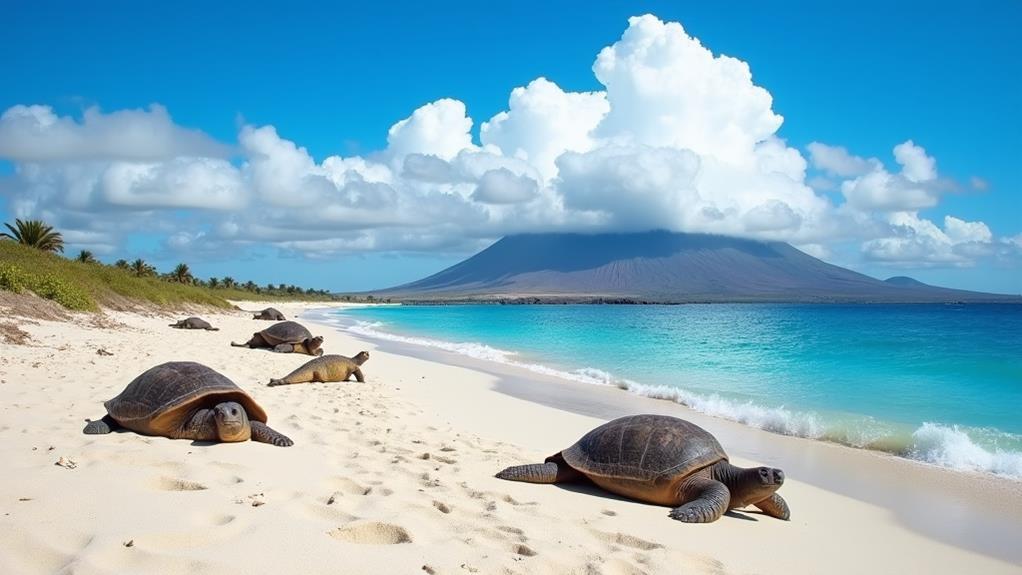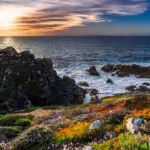When planning a trip to the Galapagos, you're likely considering the best way to experience this unique ecosystem. You'll want to start by deciding on the time of year to visit, as this will substantially impact your trip. The dry season, from June to November, offers ideal weather conditions, but what about the rest of your itinerary? Which islands should you prioritize, and what activities will allow you to make the most of your time? By focusing on your specific interests and needs, you can create a personalized itinerary – but where do you even begin?
Contents
Key Takeaways
- Prioritize interests and choose a tour that caters to specific needs, considering the time of year, activities, and islands to visit.
- The dry season, from June to November, offers ideal conditions for outdoor activities, with clear skies, cooler temperatures, and lower humidity.
- Focus on islands with unique landscapes and wildlife, such as Isabela, Santiago, Fernandina, and Santa Cruz, for a well-rounded experience.
- Consider flexibility in the itinerary due to unpredictable weather conditions and potential changes in the schedule.
- Research tour operators' reputations, read reviews, and ask about environmental policies to ensure a responsible and enjoyable Galapagos experience.
Planning Your Galapagos Trip
Dreams of a Galapagos adventure often start with a vision of untouched wilderness and wildlife that defies imagination.
As you start planning your trip, vital arrangements need to be made regarding the necessary travel documents. You'll need a valid passport, a visa if required, and a return ticket.
Make sure to check with your airline and the Ecuadorian embassy in your country for the most up-to-date requirements.
When planning your Galapagos itinerary, key considerations must be made to have some flexibility.
The islands are prone to unpredictable weather conditions, and your tour operator may need to adjust the schedule accordingly.
Be prepared for changes in your itinerary, and choose a tour operator that can adapt to these situations.
Consider the time of year, the type of activities you want to do, and the islands you want to visit when planning your itinerary.
With over 100 islands to choose from, it can be overwhelming to decide where to go and what to do.
Prioritize your interests and choose a tour that caters to your needs.
With the right planning and flexibility, you'll be able to make the most of your Galapagos adventure.
Best Time to Visit Galapagos
As you plan your Galapagos trip, you'll want to ponder the best time to visit this unique ecosystem.
You'll have two main options: the dry season, which offers clear skies and cooler temperatures, and the peak tourist season, when the islands come alive with warm weather and an explosion of wildlife.
Dry Season Benefits
Visiting the Galapagos during the dry season offers a unique experience, with cooler temperatures and lower humidity making it ideal for exploring the islands on foot. You'll have the opportunity to hike and snorkel in comfort, taking in the breathtaking landscapes and wildlife. The dry season, which typically runs from June to November, is characterized by clear skies and warm weather, making it perfect for outdoor activities.
| Month | Temperature (°F) | Humidity |
|---|---|---|
| June | 70-80 | 60-70% |
| July | 75-85 | 50-60% |
| August | 80-90 | 40-50% |
As you explore the islands, you'll notice the unique adaptations of the wildlife to the dry season. Many animals congregate around water sources, making them easier to spot. The dry season is also a great time for spotting marine life, such as sea turtles and whales. With its comfortable temperatures and low humidity, the dry season is an ideal time to visit the Galapagos, and you'll have a more enjoyable experience exploring the islands' rugged terrain.
Peak Tourist Season
During the peak tourist season, you're in for a treat – the Galapagos Islands are buzzing with activity, and you'll have ample opportunities to experience the archipelago's unique biodiversity.
The period from June to September and December to January is the peak tourist season, with the highest demand for tours and accommodations. If you're planning to visit during this time, be prepared for larger crowds and longer wait times at popular sites.
The Galapagos National Park has implemented crowd management strategies to guarantee a smooth and enjoyable experience for all visitors.
These strategies include limiting the number of visitors to certain sites and implementing a timed-entry system.
To make the most of your trip, it's crucial to understand tourist behavior patterns and plan your itinerary accordingly.
Consider visiting popular sites early in the morning or later in the afternoon to avoid the crowds.
Additionally, consider working with a reputable tour operator who can provide valuable insights and help you navigate the islands during the peak season.
Galapagos Islands to Visit
Stepping foot in the Galapagos Islands is like entering a world apart – one teeming with unique wildlife, volcanic landscapes, and untouched ecosystems. As you plan your island-hopping adventure, you'll want to prioritize the most breathtaking and remote landscapes.
| Island | Must-see Features |
|---|---|
| Isabela Island | Sierra Negra Volcano, Wall of Tears, pristine beaches |
| Santiago Island | Sullivan Bay lava flows, Bartolome Island's iconic Pinnacle Rock |
| Fernandina Island | La Cumbre volcano, Punta Espinosa's scenic shoreline |
| Santa Cruz Island | El Chato Reserve's lush forests, Los Gemelos twin craters |
With over 19 islands to explore, each one offers a distinct experience. You'll discover remote landscapes shaped by volcanic activity, erosion, and the relentless forces of nature. From the towering volcanic peaks to the serene beaches, every island is a monument to the Galapagos' untamed beauty. As you plan your itinerary, consider which islands will give you the most immersive experience. With careful planning, you'll be able to soak up the majesty of these incredible islands.
Wildlife and Unique Species
As you venture into the Galapagos Islands, you're not just exploring a unique ecosystem – you're immersing yourself in a living, breathing laboratory of evolution.
This enchanting archipelago is home to an astonishing array of wildlife that will leave you in awe.
The Galapagos Islands boast an incredible endemism, with many species found nowhere else on the planet.
- Marine Iguanas: The only lizards in the world that can live and forage in the sea, these incredible creatures will amaze you with their adaptability.
- Galapagos Finches: With their distinctive beaks and vibrant songs, these finches are a symbol of the Galapagos Islands and a key part of their unique ecosystem.
- Giant Tortoises: These gentle giants can live up to 100 years in the wild, making them one of the longest-living animals on the planet.
- Blue-Footed Boobies: With their bright blue feet and charismatic courtship displays, these birds are sure to delight.
The Galapagos Islands are a wildlife lover's paradise, with an incredible array of species that will inspire and delight you.
As you explore this enchanting archipelago, you'll be constantly amazed by the incredible diversity of life on display.
Choosing Your Tour Option
With the incredible wildlife of the Galapagos Islands fresh in your mind, it's time to think about how you'll experience this unique ecosystem.
When choosing a tour option, you'll want to ponder what type of experience you're looking for. Tour operators in the Galapagos offer a range of options, from budget-friendly cruises to luxury tours.
If you're looking for a more personalized experience, weigh the pros and cons of booking with a smaller tour operator that offers private yacht tours.
Private yachts offer a more intimate and exclusive experience, allowing you to explore the islands at your own pace.
You'll have more flexibility to create your own itinerary and make changes on the fly.
However, this option often comes with a higher price tag.
On the other hand, larger tour operators offer more affordable options and often have experienced guides who can provide valuable insights into the islands' unique ecosystem.
When selecting a tour operator, research their reputation, read reviews, and ask about their environmental policies.
Essential Packing Items
Packing for the Galapagos Islands requires careful consideration of the unique environment you'll be exploring.
The islands' tropical climate, volcanic landscapes, and wildlife-rich ecosystems demand a thoughtful approach to packing. You'll want to prioritize items that protect you from the elements, facilitate navigation, and respect the fragile ecosystem.
- Lightweight and quick-drying clothing: Pack clothes that can keep up with your active itinerary and the tropical climate.
- Sturdy hiking boots: With volcanic terrain and rugged landscapes, you'll need boots that can handle the demands of hiking and exploring.
- Reusable water bottle: Stay hydrated while reducing your plastic waste with a refillable water bottle.
- Travel adapters and converters: Ecuador uses Type A and B plugs, and 120V, so be sure to pack the necessary adapters and converters to keep your devices charged.
Consider using packing cubes to keep your luggage organized and make the most of your space.
Activities and Excursions
Your days in the Galapagos Islands will be filled with unforgettable experiences, and the right activities and excursions can make all the difference.
From exploring volcanic landscapes to encountering an incredible array of wildlife, there's no shortage of adventure to be had.
For thrill-seekers, scuba diving is a must-do experience in the Galapagos. Explore the crystal-clear waters of Wolf and Darwin Islands, where you can swim alongside whale sharks, sea turtles, and an incredible array of marine life.
If scuba diving isn't your thing, don't worry – snorkeling adventures are just as exciting.
Visit the famous Devil's Crown, a coral reef surrounded by crystal-clear waters teeming with sea turtles, rays, and tropical fish.
Take a guided tour to explore the islands' hidden coves and bays, where you can snorkel in the company of playful sea lions and curious penguins.
Whatever your preference, the Galapagos Islands offer endless opportunities for adventure and exploration.
With the right activities and excursions, you'll be able to experience the islands' unique beauty and magic up close.
Budget and Cost Breakdown
Budgeting for your Galapagos adventure can be a challenging task, but breaking down costs helps you plan your trip more effectively.
The Galapagos Islands are an expensive destination, and understanding the expenses involved will help you make the most of your trip. The official currency of the Galapagos Islands is the US dollar, but you'll still need to weigh currency exchange rates if you're traveling from outside the US.
- Flight costs: Round-trip flights from Quito or Guayaquil to the Galapagos Islands can range from $400 to $700.
- National park fees: A one-time fee of $100 is required for all visitors to the Galapagos National Park.
- Accommodation costs: Prices for hotels and lodges vary greatly, but expect to pay between $150 and $500 per night.
- Boat tour costs: A 4- to 5-day boat tour can cost anywhere from $1,500 to $3,000 per person.
Don't forget to factor in the cost of travel insurance, which is highly recommended for any trip to the Galapagos Islands.
Frequently Asked Questions
Can I Bring My Drone to the Galapagos Islands?
When traveling, you'll want to know: can you bring your drone to capture stunning island photography? Unfortunately, you'll face strict drone regulations in the Galapagos, requiring permits and restrictions, so plan ahead and check with authorities first.
Is Wifi Available on Galapagos Cruise Ships?
You're about to set out on a digital detox, but not entirely – 70% of cruise ships worldwide now offer Internet access. On Galapagos cruise ships, onboard connectivity varies, but many offer WiFi, albeit expensive and limited.
Do I Need a Power Adapter for Ecuador?
When traveling to Ecuador, you'll need to ponder voltage concerns, as they use 120V, and plug types, with both A and B types being used. You'll likely need a power adapter to stay charged.
What's the Best Way to Stay Hydrated on Tour?
When in a dry spell, drink up. You'll want to stay hydrated on tour by packing electrolyte tablets and a hydration pack, making it easy to drink plenty of water throughout the day.
Can I Snorkel or Dive With a Medical Condition?
When snorkeling or diving with a medical condition, you'll need to assess your heart health and lung safety. If you have heart conditions, consult your doctor, and consider a dive medical exam to guarantee a safe underwater experience.
Conclusion
You've got your dream Galapagos itinerary in the works. As you finalize your plans, remember that UNESCO has designated this unique ecosystem as one of the most biodiverse places on the planet – with an astonishing 97% of its landmass protected as a national park. With careful planning, you'll experience the best the Galapagos has to offer, from giant tortoises to marine iguanas, in one of the most pristine environments on Earth.









